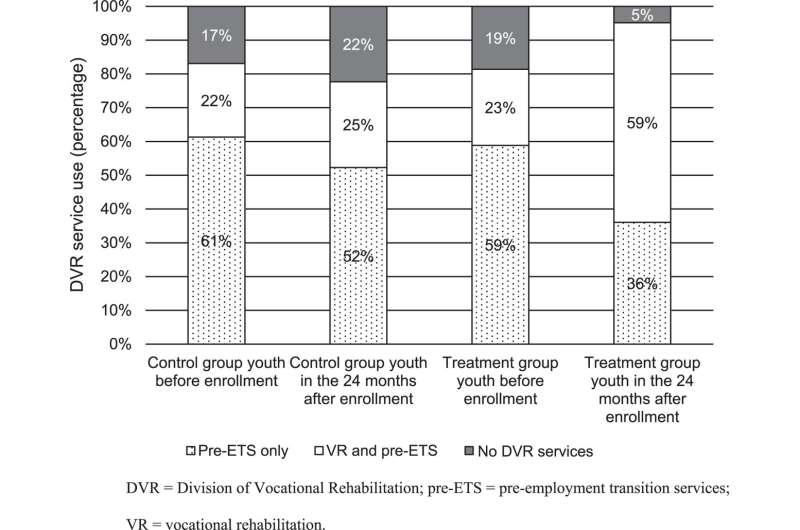This article has been reviewed according to Science X's editorial process and policies. Editors have highlighted the following attributes while ensuring the content's credibility:
fact-checked
trusted source
proofread
Participation in careers programs found to increase engagement with vocational services

A new study published in the Journal of Vocational Rehabilitation evaluates the impact of Vermont's Linking Learning to Careers (LLC) program on service usage patterns and outcomes of participating high school students with disabilities, compared to a control group.
The findings demonstrate how the LLC intervention, which emphasized work-based learning experiences, resulted in participants across all demographic groups using more pre-employment transition services (pre-ETS) and vocational rehabilitation services offered by the state's Division of Vocational Rehabilitation. In addition, participation in the LLC program resulted in higher earnings for students with work experience.
"When we completed the evaluation of the LLC demonstration program, we wanted to understand the differences in the use of vocational rehabilitation and pre-ETS. We found some notable differences in service use, at least in Vermont, and it's likely true that there are differences in other states, too," explained lead investigator Todd Honeycutt, Ph.D., Mathematica, Princeton, NJ.
"An intentional, comprehensive approach to offering vocational rehabilitation services to youth with disabilities can increase youth's involvement with a vocational rehabilitation agency. LLC encouraged more youth to use more services, erasing the uptake variations in service use across demographic groups that are evident in other programs. Moreover, students who used work experiences had higher rates of quarterly earnings than students who used other services," he added.
The study used administrative data from the Vermont Vocational Rehabilitation Agency to track the demographics of the participating youth (e.g., age, sex, race and ethnicity, and health condition), the vocational rehabilitation services they used, and their earnings.
The 413 participants in the group who had access to LLC demonstrated greater engagement with the services of the state vocational rehabilitation agency than the 390 participants in the control group with access to other vocational rehabilitation services. In the latter group, females and special education program users were likelier to take advantage of services. Among LLC participants, however, there was no demographic variation in uptake of the array of services.
Youth and young adults—24 and younger—currently comprise more than half of vocational rehabilitation participants nationally.
Comprehensive transition programs like LLC are designed to help young people with disabilities transition from secondary school to employment and vocational and higher education by offering special services, such as counseling on opportunities for enrollment in comprehensive transition or postsecondary educational programs, instructions on self-advocacy, and work-based learning experiences.
These services stand apart from the standard services traditionally offered by vocational rehabilitation agencies.
Because disparities exist in awareness, access, and service use, vocational rehabilitation staff may find it helpful to learn about whom they may or may not be reaching with their services.
According to co-investigator Purvi Sevak, Ph.D., Mathematica, Princeton, NJ, "State vocational rehabilitation agencies are investing a lot of resources into services for students with disabilities."
"We know a lot about the services those students use, but we don't know enough yet about who uses which services and what happens to them afterward. Why is that important? Because just offering services to students may not be enough to get the results we all hope for. This study is a small step to filling in those gaps."
More information: Todd Honeycutt et al, Pre-employment transition and vocational rehabilitation services: Experiences in response to Vermont's work-based learning program, Journal of Vocational Rehabilitation (2023). DOI: 10.3233/JVR-230055
Provided by IOS Press



















